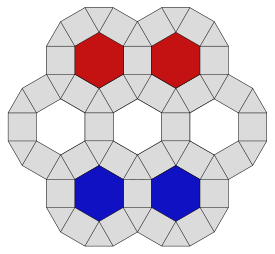
- Tabletop games
- Board games
- Tile-based games
- Turn-based games.html
- Abstract strategy games
- card games
- Connection games
- Mancala games
- Paper-and-pencil games
- Word games



 Kensington gameboard illustration showing rhombitrihexagonal tiling
Kensington gameboard illustration showing rhombitrihexagonal tilingKensington is an abstract strategy board game devised by Brian Taylor and Peter Forbes in 1979, named after London's Kensington Gardens, which contains the mosaic upon which the gameboard is patterned. It is played on a geometrical board based on the rhombitrihexagonal tiling pattern.
The gameboard geometry is based on rhombitrihexagonal tiling and consists of a combination of regular hexagons, squares, and triangles.
The two players, Red and Blue, alternately place pieces on the intersections of the board until each has placed fifteen. Thereafter they alternate turns sliding a single piece along a line to an adjacent vertex. The object is to place pieces on the six vertices of a white hexagon or a hexagon of one's own colour.
If a player forms a triangle, he is entitled to relocate one enemy piece. If a player forms a square, he may relocate two enemy pieces. Forming a triangle and a square simultaneously allows one to relocate only two enemy pieces.
At first it seems that whoever makes the first triangle or square is almost assured of being able to scatter the opposing pieces and win without difficulty, so one commonly expressed strategy revolves around being first to begin scattering. However, relocation becomes more challenging as the game progresses and the distribution of pieces changes. The placing and movement of pieces has been compared to Nine Men's Morris.
In a business venture parallel to Trivial Pursuit in Canada, the British inventors set up their own company to make and publish the game. This attracted a fair amount of press attention at the time and Kensington picked up a UK Game of the Year award. Attention for the game was short-lived and the game is now out of print.
A 1979 edition was sold in a package resembling a double-LP album. The front part had a cut-out showing the centre of the one-piece non-folding gameboard which could be slid out of the sleeve like an LP. Rules were printed on the inside and the rear side showed the authors playing the game on the steps of the Albert Memorial. In the rules the authors offered a prize of £10,000 to the first person to find a position in which neither player of a two-player game could move.